#seeing as the one on my main is perpetually outdated and also it’s just easier to have it here
Explore tagged Tumblr posts
Note
hiiii i'm a big huge fan of cave horror and love the mad stone comic you drew, can i ask what the story's about?? O:
omg thank you so much!!!! and YES always: that comic is from my original work signal to noise, which follows historian samira hashemi as she tries to construct a comprehensive and complete history of the post-post apocalyptic world she lives in. the story follows a small collection of the historical texts that samira is decoding and piecing together, as well as samira’s own account of her attempt to find the ‘heart’ of a place called the synapse, which is a place of chance and change that is often functionally (and sometimes literally!) a cave. three of the stories total are about various groups exploring the synapse and the things that happen to them there; this is where the cave horror is!!
the mad stone series specifically is about a possibly-historical possibly-mythological figure known only as the unnamed caver, who is often described by cavers but whose story is relatively unknown. if samira were to uncover her story, it would make many parts of her history lock into place - the question is if she’ll find the pieces the unnamed caver left behind!!
#asks#dendrogaster#Great url too btw!!!! and thank you this is a good excuse to actually have a signoise explainer easily accessible on this blog#seeing as the one on my main is perpetually outdated and also it’s just easier to have it here#i need to signoise post on here more often..#signal to noise#<- feel free to explore the rest of the tag too!! though some of that is erm. Old
5 notes
·
View notes
Text
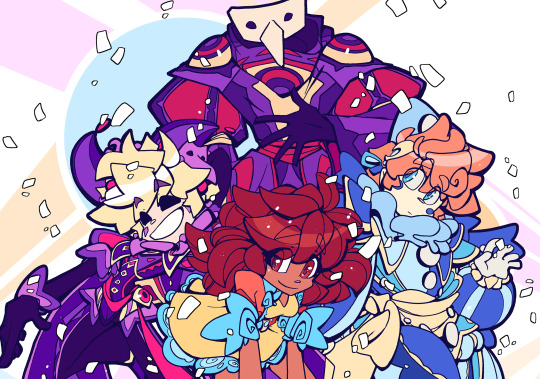
Much like for the other OCverses, heres my stockpile of Delta stuff + the full lore. I dont draw it as much and only settled on its style very recently but well. here you go.
this is an outdated design lineup but it conveys the general vibe, in order its Rhea, Rem, Pierrot, and Raken.

Raken is the ""boss"" as the nightmare lord, something akin to a librarian of nightmares (creating, cataloging, and dispatching nightmares.) he took on Rem as his acolyte first and the two have been working together for thousands of years, Pierrot defected from the dream kingdom more recently (hundreds of years ago) after learning of the dream queen's plans, and Rhea is a very very new addition (few months).
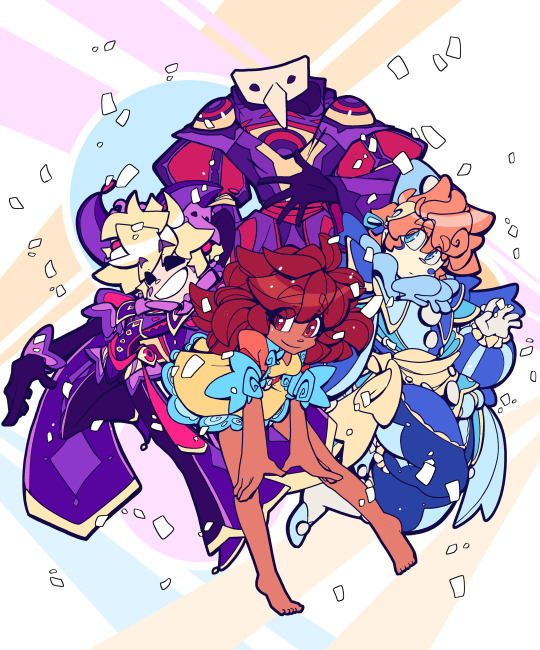
the main conflict is the dreaming kingdom, the main regency that creates and dispatches dreams, going awol and trying to protect people from the waking world by trapping them in neverending, perfect dreams. Raken and Rem get that this is Not Great and are working to stop them and save people.
Rhea and Rem are the main protagonists, both are talented lucid dreamers that are able to manipulate the environment and reality around them.
Rem is wicked smart and extremely competent. Rem is the sort of head hech between the three henchmen. At first hes this charming, upbeat organized friend trying to preserve their morale during their fundamentally morally complex and messy task of giving people nightmares to wake them up. He’s someone Rhea and Pierrot turn to for advice, and he calls the shots outside of Raken.
Oh also he doesnt have eyes because he voluntarily gave them up as a display of loyalty to Raken, of which Raken did not ask for and was deeply disturbed by but whats done is done.
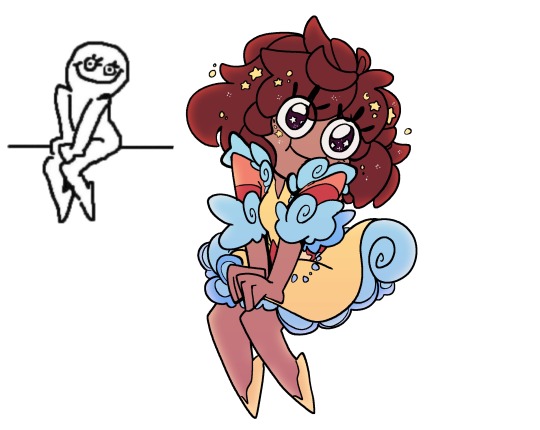
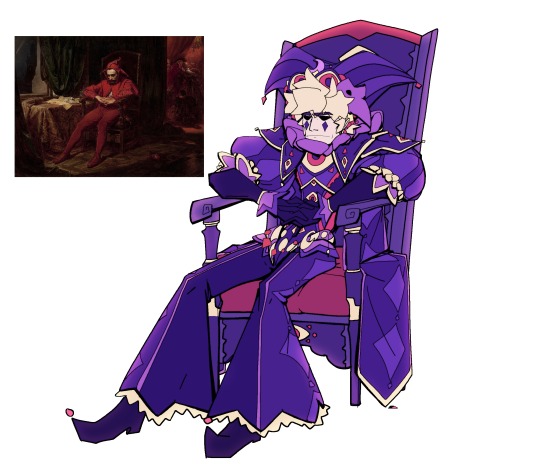
Rhea is sociable and charismatic. Shes optimistic and has an intense, perfectionistic ambitious drive. She doesnt just want to solve the problem, she wants to solve it the best its ever been done with triumphant applause. She works very hard to find a “perfect” resolution that convinces the dream queen to stop, addresses the harshness of the waking world, and doesn’t involve giving people a worse alternative in the form of horrific nightmares every night, as unrealistic as that outcome is. Rhea is very skilled with dreaming magic largely from natural talent and unusual creative angles to problems. she also thrives with the cutie patootie offensive, charming people instead of having to fight them.
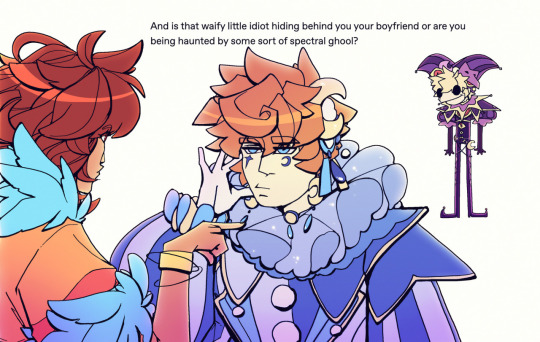
Rhea and Rem are these top of the line prodigies, and Pierrot is just......sort of there. He’s not especially talented in any one category, nor is he immediately deft from a social perspective. Pierrot is sort of a loser ngl, hes nowhere nears as talented, skilled, smart, or capable as the others, he just wants to do the right thing and for his life to be easier but hes constantly stuck in situations that are over his head, perpetually struggling. He has a good heart and strong moral compass and is actually able to see problems far more clearly than Rhea, who gets tunnel vision around perfectionism, and Rem, who gets swayed by his emotions very easily.
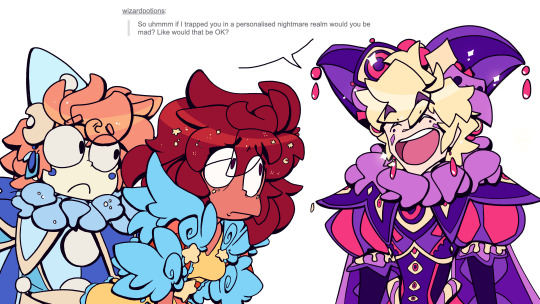
For the first half of the story, the three henchmen are best friends, but after Rhea defects to do her own thing and Pierrot goes with her, Rem snaps and they go from "besties squad" to squaring up on sight. Rem takes them leaving as directly personal, a "youre bad and I hate you" instead of "hey i dont want to give people nightmares anymore". if you watched the she-ra reboot, its a lot like how catra processes things.
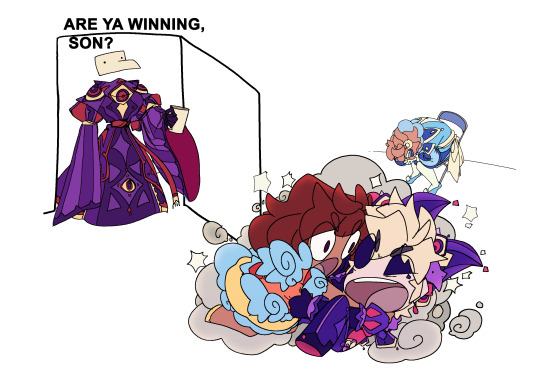
after they leave he goes full sicko mode and starts creating nightmares for a less noble cause, from "i have to do this for the greater good" to "fuck you 10,000 years spider mouth hatman torture nexus blast" and is obsessively fixated on Rhea and Pierrot. Through unfortunate events he inherits the title of nightmare lord and things Do Not Go Well once he takes the mantle. (because Rem used to be a real person but Raken is a pure dream denizen, at one point during a fight Rem says "I wish you didnt exist" and since Rem is objectively real but Raken only exists in the dream concious space....he accidentally deletes his dad and finding out him and rhea can do that freaks him the fuck out even further)
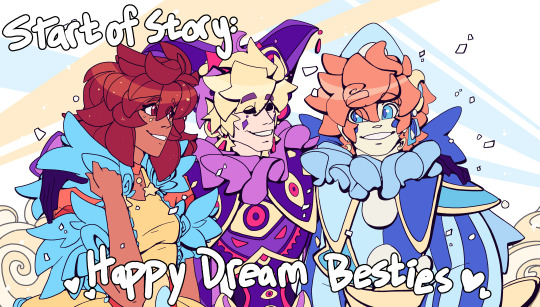
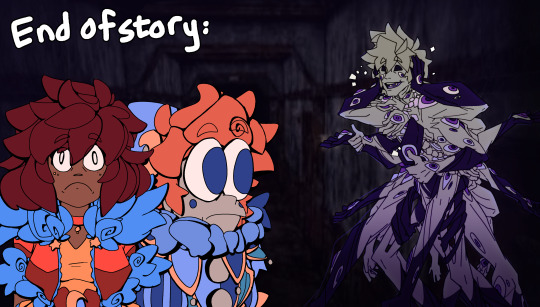
while the dream kingdom is getting more desperate in their attempts to "save people" and Rem is going completely off his rocker in the corner, poor Rhea ends up being the only and only person trying to pull everything back together.
I have a few alternative endings about what happens as the resolution depending on how mean i want to be, but most of them involve Rhea finding some hodgepodge solution and waking up again, Rem finally chilling the fuck out and becoming a more stable nightmare lord.

At some point I keep meaning to draw the foil trio in the dreaming kingdom, Lélio (Rem's foil who has everything he wants), Isabella (Rhea's foil because if you think im not also going to write an insane wlw situationship you are wrong) and the sandman as Pierrot's foil. Also the dream queen and more tangibly what the two kingdoms look like between dreams and nightmares but ideas are many and energy is little.

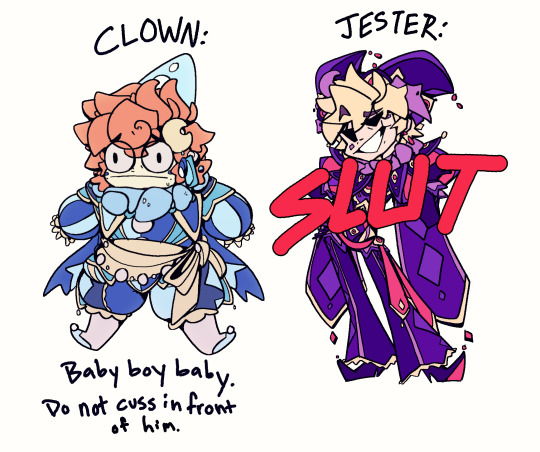
14 notes
·
View notes
Text
The Hyuuga Clan: what not to do
So I promised a separate post on the Hyuuga Clan plotline after I wrapped up the Chuunin Exam arc, and as promised, here it is. It’s been a long time coming, so let’s get started, shall we?
To recap the Hyuuga Clan plotline, the whole thing starts when Neji and Hinata, previously introduced separately earlier in the Chuunin exam arc, face each other in the preliminaries. It’s an unpleasant, vitriolic match: Neji brutalizes his cousin in the course of their fight, and comes damn close to killing her. The only reason Hinata doesn’t die right then and there is due to the intervention of the Leaf jounin-instructors. Fandom often attributes this to Naruto’s support, but I would argue that’s unfair to Hinata; in one of the few self-motivated acts she does, she tells Neji he’s wrong about her, about the world, and most importantly, himself—which enrages him to the point of going for a killing blow.
Anyway, Neji is thoroughly unlikeable, and Naruto swears he’ll cut the other kid down to size during his match with other boy. Blah blah blah, take a month-long break, time to fight. As becomes usual for Naruto’s villain face-offs, they fight and Neji monologues: he explains why he’s so angry at Hinata (and the Main House) even though they’re family. Essentially, the Branch house of the Hyuuga all have a seal on their forehead that destroys their eyes upon death, ensuring their valuable bloodline limit can't be stolen. That actually sounds really cool except for one thing: it's also used as a method of brutal control by the Main House, who have the ability and knowledge to manipulate the seal's destructive capacity to inflict agonizing pain on those who bear it. Moreover, Hinata and Neji aren't just people from the same clan—they're actually first cousins—and considering their respective fathers are identical twins, you could make a very strong case for them being closer to half-siblings than anything else.
Neji is angry for two reasons, one abstract and one personal. The abstract reason is this: Neji is a gifted prodigy in his clan's techniques, but because he's part of the Branch House, he's unable to get the training and, yes, recognition he deserves as a Gentle Fist prodigy. Hinata is only average in the abilities the Hyuuga value—namely having advanced control over her bloodline and the combat skills to go with it—and if Neji's father had been born first instead of her own, their lives would be unimaginably different. The personal reason is that ten years ago, Neji's father was sacrificed to appease some politically powerful bloodline thieves, who attempted to kidnap Hinata, presumably because she was young, had a good pedigree, and also had a womb. Long story short, Naruto beats Neji up and tells him to "cheer up emo kid!". The story doesn't end until Neji reaches some kind of catharsis with his uncle, Hinata's father, and decides he too will live free like a bird, blah blah blah. Yay! Story concluded, right?
Fandom didn't think so, and rightly so! Konoha is revealed to have a large, politically powerful clan that is essentially enslaving a least half (and perhaps more) of their own population, and using it for unspeakable reasons. Leaving aside Neji's sort of weaksauce resolution, Hinata, meek and unmartial, has a younger sister who is strong in all the ways she isn't; Just like with her father and his brother, will she have to brand her younger sister to maintain the right of absolute primogeniture?
And make no mistake, that is the real issue at the heart of the Hyuuga clan. Everything else is just window dressing. Even ignoring the stupidity of the Hyuuga sacrifice—Really, Sarutobi? Really?! —the Hyuuga story always had more holes in it than good swiss cheese. As I mentioned in my re-read summary post for volumes 11-13, the combination of "sealing most of the family" and also "preventing the sealed kin from learning the full extent of the Gentle Fist" only makes sense if the Hyuuga were alone in the wilderness, but in a village setting where the vast majority of sealed Hyuuga are supporting village operations, it sounds like a bad deal for the Leaf, since they're only getting half-trained soldiers in return for allowing the Hyuuga to live within their walls. The entire purpose of Neji's story is just a clumsy way to highlight the injustice of absolute primogeniture as a method of both advancement, inheritance, and simple justice in traditional society.
I don't think it's an exaggeration that the "Clan Hyuuga eats its children" genre of stories was one of the more popular family-centered tropes in fanfiction in the pre-Shippuden era. The sand sibs and Uchiha brothers might have had more written about them, but not by much. How Hinata, Neji, and Naruto would grapple with the Hyuuga Clan's outdated social norms was the focus of a lot of stories and there was a lot of expectation about how Kishimoto was going to resolve this issue in part 2. Now that Naruto has come to an end, we can all throw up a little in our mouths, because it's clear Kishimoto thought he already had.
Any of Hinata's character growth in part two comes from her relationship to Naruto; Neji dies sacrificing himself for her and Naruto, which seems damn empty given that we never see the cousins reconcile or really interact all that much. Hanabi is a non-entity. The Hyuuga Clan, as of Chapter 700, is still presumably sealing and oppressing the majority of its members. The only way to understand this extremely unsatisfactory turn of events is to see it as an intersection of two unpleasant trends in Naruto: women are always secondary to men in terms of character development and plot importance, and villainous motivations are tailor-made to whatever the hell sort of lesson Naruto is supposed to impart to them as the hero of this story.
Women, in Naruto, are almost always secondary to the men they are related and associated with. Mito only shows up in context of her husband, never mind that she was apparently a master in her own right; like Sakura's relationship to Naruto and Sasuke, even the relationship between a man and his wife is secondary to the strong bond between her husband and Madara, his "best friend". Kushina, again, was another cool character who could have been very interesting...except that she was immediately subordinated to her husband's plot, and then later her son's. Kurenai's griefs and plots are centered around Asuma and Shikamaru; Sakura had the glimmerings of her own story, but it was always shoved aside for the Naruto and Sasuke thing. Rin is probably the worst example; she literally only exists to traumatize Obito and Kakashi with her death. Hinata is just another character in that tradition.
For the sake of argument, separate Hyuuga Hinata, clan heir from Hinata, Naruto's love interest. Just pretend there are two girls with that given name in Naruto—actually, let's make it even easier. Hinata the girl is Naruto's love interest; Hinata the clan heir is a boy. Hinata the boy isn't a bad person, but he's shy, meek, unassuming, and not very good at combat. He is a constant disappointment to his father, who wanted a child much like Hinata's cousin, who is everything Hinata isn't: strong, capable, and ruthless. In a different world, his cousin Neji would be clan heir—except their family practices absolute primogeniture as a method of inheritance. Neji's father is younger than Hinata's father and was thus forced into the lesser branch family and blocked from ever inheriting. Hinata has a younger brother, as well, who is also better than Hinata in all the ways that matter to their family, and one day, Hinata will have to brand his younger brother and cast him aside, all to uphold their tradition. Hinata is despised by his cousin (and maybe his brother) because they both know they are better than him, but because of their family's stupid rules, they are forever subordinate to the lesser. But Hinata has his own skills: in a family with eyes that see nearly everything, save for one specific blind spot, Hinata has the gift of seeing just what they lack. Can Hinata find a way to prove that might does not make one right? Can he show that it's not strength of arms that makes a good leader? Can he find a way to unite his broken family, and right the injustice they have perpetuated among themselves?
That's an interesting story, isn't it? But Kishimoto wasn't really interested in writing a story about why absolute primogeniture is stupid; he wasn't interested in writing a story about what makes a good leader and how to grow up to be a just one, either. Hyuuga Hinata, clan heir, was extraneous; that whole facet of her character could have been a separate one-shot character who just showed up in Neji's villain arc like so many others, given her importance as clan heir after this point.
Now that Naruto's over, it's obvious the whole horrible Hyuuga clan background was just another tragic villainous past for Naruto to defeat in a stupid fight. It's infuriating because it's literally is a schoolyard fight—it's not exactly a demon trapped in a little boy, or the survivors of a brutal foreign war finding the only way to protect themselves is destroying everyone who opposes them. Kishimoto didn't have to write a caged bird seal plotline; he didn't have to make the Hyuuga so brutal to their own kin. Neji didn't even need to try and murder his cousin, just beating the shit out of her would have been enough. The whole thing could have been written as a simple family drama about the unfairness of absolute primogeniture, no seal needed, just the weight of "we've always done it this way". Kishimoto wrote it for the explicit purpose of first making Neji horrible and cruel, then revealing, like all the rest of Naruto's villains, why he is deserving of pity for his "terrible" deeds.
Ultimately, Kishimoto wrote the Hyuuga the way he did because he's almost incapable of writing a character who does bad things without having a sad past; and he's incapable of that because he's a lazy writer who doesn't want to go through the work of actually writing interesting characters. The entire Hyuuga family plotline is the sort of manipulative asspull I hate in both professional and amateur writers, the sort of crutch a weakling uses to pass over another character’s flaws. Hinata, in this story, only exists to show how fucked up Neji is because of her father's actions. She certainly never gets any resolution to her father treating her poorly, or the fact that her cousin tried very hard to kill her in public view. The central tension in the Hyuuga clan is between Neji and Hiashi, which is why the arc closes with Hiashi apologizing to Neji, and then Neji deciding to make his own way in life despite the seal, like his father did.
And Hinata, who is despised for weakness by her father; who is nearly killed for having the temerity to point out Neji's own blind spot; who is physically weak, but has the glimmers of a character stronger than both her cousin and father combined, if only Kishimoto had been interested?
Like Mito, and Kushina, and Rin, and Kurenai, and Sakura, and Anko, and yes, Karin, and every other goddamn woman in this manga - like them, she's only a prop in someone else's story. And in turn, that other person's story is just a prop for Naruto to defeat on his way to becoming a hero.
397 notes
·
View notes
Link
10 Reasons to Support Mercury-Free Dentistry Dr. Mercola By Dr. Mercola It's Mercury Awareness Week — a time when I focus on how and why we, together, can end the use of dental amalgam, which has no role in 21st century dentistry. By now you likely know that amalgam dental fillings are 50 percent mercury — a toxic heavy metal that has no place in the human body. But do you know about all the many other problems caused by this outdated dental product? Next time a pro-mercury dentist tries to illogically claim that the mercury in their amalgam is perfectly safe, as the Boy Scouts motto goes, "Be Prepared." Today I give you 10 more reasons to support mercury-free dentistry. The bottom line is no one should receive mercury fillings, despite what the pro-mercury dentists, insurance companies and the government bureaucrats say! The campaign for mercury-free dentistry is led by an effective nonprofit group which spends its funds carefully and efficiently: Consumers for Dental Choice. I have worked closely for several years with its leader, Charlie Brown, and I continue to see the results we need. So, I now step up to match all donations received until August 20, 2018. This year, I've raised the match ceiling by 25 percent, from $100,000 to $125,000. With my match, here is a way for you to double your charity money! >>>>> Click Here <<<<< Checks can be mailed to: Consumers for Dental Choice 316 F St., N.E., Suite 210 Washington DC 20002 Reason No. 1: Amalgam's Mercury Puts Children at Risk Amalgam emits mercury vapor even after it is implanted into the body. This mercury is bioaccumulative and crosses the placenta to accumulate in fetuses, as well. Dental amalgam's mercury is a known health risk, especially for children, fetuses, nursing infants and people with impaired kidney function. Even the U.S. Food and Drug Administration (FDA) concedes that the developing neurological systems of children and fetuses are more susceptible to "the neurotoxic effects of mercury vapor," and that there is no evidence that amalgam is safe for these populations. Now Consumers for Dental Choice is working to make FDA take action to end amalgam use in children — a step the European Union (EU) has already taken. Via citizen petitions, coalition-building, workshops, international pressure and grassroots organizing, they will succeed! You can join in by signing Consumers for Dental Choice's online petition. >>>>> Click Here <<<<< Reason No. 2: Amalgam Damages Your Teeth Placing amalgam requires the removal of a significant amount of healthy tooth matter. This removal weakens overall tooth structure, which increases the need for future dental work. On top of that, amalgam fillings — which expand and contract over time — crack teeth, once again creating the need for more dental work. Consumers for Dental Choice is bringing to light this lesser known health consequence of amalgam, making sure that policymakers and patients know about it too. Reason No. 3: Amalgam Pollutes the Environment Amalgam pollutes 1) water via dental clinic releases and human waste; 2) air via cremation, dental clinic emissions, sludge incineration and respiration; and 3) land via landfills, burials and fertilizer. Once in the environment, dental mercury converts to its even more toxic form: methylmercury and becomes a major source of mercury in the fish people eat. Dental mercury in the environment can cause brain damage and neurological problems, especially for children and the unborn babies, according to the United States Environmental Protection Agency. Consumers for Dental Choice was instrumental in getting amalgam recognized as a significant environmental problem at the negotiations for the Minamata Convention on Mercury, an environmental treaty that requires countries to reduce their amalgam use. In the meantime, Consumers teamed with environmental allies to successfully convince the U.S. Environmental Protection Agency (EPA) to require separators in dental offices to catch amalgam's mercury before it enters the wastewater. Reason No. 4: Amalgam Endangers Dental Professionals Due to mercury exposure from amalgam in the workplace, studies have shown dental workers have elevated systemic mercury levels. Few of these dental workers — mostly women of child-bearing age — are given protective garb or air masks to minimize their exposure to mercury; many are not aware of the risks of occupational mercury exposure. As a result, dental workers have reported neurological problems, reproductive failures and birth defects caused by amalgam in the workplace. Consumers for Dental Choice has been raising awareness of the occupational hazards of mercury in the dental office by working with dental schools and professors, as well as supporting projects to measure the level of mercury in the air in dental clinics to demonstrate just how much mercury dental personnel are exposed to. Reason No. 5: Amalgam Perpetuates Social Injustice While middle class consumers opt for mercury-free filling materials, people in developing nations, low-income families, minorities, military personnel, prisoners, and people with disabilities are still subjected to amalgam. Dentists place almost 25 percent more mercury fillings in American Indian patients than in white patients. In his testimony before Congress, former Virginia state NAACP president Emmitt Carlton described this injustice as "Choice for the rich, mercury for the poor." Consumers for Dental Choice's Medicaid campaign aims to right some of these social injustices by ensuring that even low-income patients have access to mercury-free fillings. For example, they are challenging Connecticut's Medicaid program that decreed "Medicaid will not pay for composite restorations in the [adult] molar teeth regardless of whether the [dental] practice markets itself as 'amalgam free'" and tells dentists, "If your office cannot provide amalgam services, please have your patients call the Connecticut Dental Health Partnership (CTDHP) … to locate a new dental home." Here is your opportunity, with my matching funds, to double the impact of your dollars, and accelerate the end of mercury fillings: >>>>> Click Here <<<<< Reason No. 6: Amalgam Is Frequently Used Unethically Most dentists do not inform consumers that amalgam contains mercury. As a result, over 76 percent of consumers do not know that amalgam is mainly mercury, according to Zogby polls. Once informed of this fact, 77 percent of people said they did not want mercury fillings — and were even willing to pay more to avoid this unnecessary source of mercury exposure. Consumers for Dental Choice has not only documented this problem with Zogby polls, but they have worked to secure and enforce the distribution of amalgam fact sheets in Connecticut, Maine, New Hampshire, California and the city of Philadelphia. Reason No. 7: Amalgam Is More Expensive Taxpayers foot the bill for the environmental cleanup of amalgam and the medical care associated with mercury-related health problems. Meanwhile, the dentists who dump their mercury into our environment and our bodies are not held financially liable. Consumers for Dental Choice documented the high environmental cost of amalgam in the economic report, "The Real Costs of Dental Mercury."1 After environmental costs are added up, each amalgam filling can cost up to $87 more than a comparable composite filling, and that does not even include the added health costs associated with mercury exposure and tooth damage. Reason No. 8: Amalgam Gets Diverted to Illegal Gold Mining and Other Unlawful Uses Amalgam is commonly shipped to developing countries labeled for dental use, but is then diverted to illegal use in artisanal and small-scale gold mining. Not only are the miners exposed to the risks of mercury poisoning, but the dental mercury they use to extract gold is released into the environment. Consumers for Dental Choice works to raise awareness of these issues, especially in developing countries where illegal gold mining is more common. By teaming with environmental organizations on the ground in these countries, we are able to efficiently spread the word about this unintended — and still dangerous — use of amalgam. Reason No. 9: Amalgam Holds Back Progress The continued use of amalgam keeps the price of mercury-free filling materials high by decreasing demand for these alternatives. As use of mercury-free materials increases, their price is expected to decrease even further. Additionally, insurance companies that rely on amalgam as the standard filling hold back progress in dentistry by artificially driving demand away from mercury-free fillings. Consumers for Dental Choice is challenging insurance companies with its Demand Your Choice campaign, which urges consumers to speak out against insurance companies that take their money and then only cover mercury fillings. Reason No. 10: Amalgam Has Been Surpassed by Alternatives Mercury-free dental fillings have been developed and studied for over 50 years. As a result, a wide variety of alternatives to amalgam fillings are available today; the most popular mercury-free filling is composite. As Consumers for Dental Choice explains to government officials, dentists and consumers worldwide, mercury-free dental fillings offer many advantages because in addition to not containing mercury, they are: Environment-friendly: Composites and glass ionomers are mercury-free and there is no evidence of environmental toxicity. Preserve teeth: The placement of mercury-free fillings allows for less tooth destruction, which preserves more natural tooth structure. Composites fillings can also strengthen and enhance biomechanical properties of the restored tooth. As a result, the tooth itself can survive longer. Easier to repair: Composite fillings are easier to repair than amalgam, which can save you both tooth structure and money. Durable: Recent studies show that properly placed composite fillings can last just as long as, or even longer than, amalgam fillings. Prevent caries: Glass ionomers, used in atraumatic restorative treatment (ART), have proven valuable in certain clinical situations where they can be more accessible and less expensive than amalgam (for example, in communities without electricity). User-friendly: All properly trained dentists can place mercury-free fillings in any tooth requiring a filling. If a dentist tells you he or she has to use amalgam because it is too hard to use a mercury-free filling in your tooth, find a more competent dentist! How You Can Make a Difference With so many reasons to end the use of amalgam, I urge you to contribute to Consumers for Dental Choice, the advocacy wing of the mercury-free dentistry movement. Donations are tax deductible and can be made online at ToxicTeeth.org. Please join me with every dollar you can. I promise you that I will double it! Thank you for supporting mercury-free dentistry. >>>>> Click Here <<<<< Checks can be mailed to: Consumers for Dental Choice 316 F St., N.E., Suite 210 Washington DC 20002 Protect Your Children and Yourself Now Find a mercury-free dentist who recognizes the many problems with mercury fillings and provides non-mercury fillings today! The following organizations can help you find a mercury-free dentist in the U.S. and (in some cases) internationally: Consumers for Dental Choice Dental Amalgam Mercury Solutions (DAMS). Email [email protected] or call (651) 644-4572 for information packet Holistic Dental Association Huggins Applied Healing International Academy of Biological Dentistry & Medicine (IABDM) International Association of Mercury Safe Dentists (IAMSD) Talk International
0 notes
Text
You're Probably Doing Link-Building Wrong: Google can be really frustrating sometimes. If you've been in SEO for anytime at all, you know exactly what I'm talking about! Google's success and global search market dominance have largely hinged upon its ability to perpetually evolve and provide the best user experience possible. As a result, SEO is in a constant state of flux. It's literally always changing! But one thing that hasn't changed is the fact that quality links are the foundation of nearly every successful SEO campaign. Although many people have been predicting the demise of links as a primary ranking signal for years, link-building is still very much alive and quite well. According to First Page Sage, links are still the number one ranking signal in Google's algorithm in 2017. As they point out, inbound links have been the primary currency Google uses to determine its level of trust for a website since the search engine established itself in 1998. It worked for them then, and it still works for them now. So, yeah… Link-building is kind of a big deal, regardless of what the naysayers may think. And this means one thing. You need to have your link-building on lock. Unfortunately, many link-building campaigns are full of holes due to misconceptions and misunderstandings as to what Google is really looking for. It can be especially brutal for noobs, who are just getting their feet wet. Here are some of the most common link-building mistakes SEO marketers make and how to resolve them. Botching anchor text The great anchor text debate has raged on for a few years now. Okay, maybe that sounds overly epic, but employing anchor text is one of the most misunderstood aspects of link-building. Back in the day, you could often outrank the competition by simply being obnoxious and going crazy with exact match anchor text (the keyword phrase you're trying to rank for.) But Google quickly discovered that way too many people were gaming the system and launched a counterattack with Penguin in 2012. They tweaked their algorithm, and the sites that went overboard on exact match anchor text were penalized. Of course, SEO marketers didn't want to incur the wrath of Matt Cutts and his minions, so they did the only sensible thing. They went the opposite direction. Many people ceased to use exact match anchor text altogether. And I can totally see why. To be honest, I'm still a little sketched about using exact match anchors. But here's the thing. Doing anchor text the right way can be encapsulated in one word: natural. If it's natural, you're good to go. What exactly do I mean by natural? You want to make sure you're diversifying your anchor text and not going overboard with any particular format. The different types of anchor text When you break it down, there are six main types of anchor text: Exact match – Like I already explained Partial match – This contains the keyword phrase you're trying to rank for but isn't exact Branded – The name of your brand Naked URLs – This is the URL exactly how it appears in your browser Generic (also known as junk anchors) – Some examples would be “check this out” or “click here” LSI – This is latent semantic indexing, which is variations of your keyword. If this still seems a little vague, here are examples provided by Ahrefs: Speaking of Ahrefs… They performed some extensive research on anchor text fairly recently (mid-2016) to determine its impact on SEO. There's a ton of data, which can be a little confusing if you're not an SEO nerd. Allow me to give you the key takeaways. First of all, anchor text continues to play an integral role in link-building, and SEO in general, and is unlikely to change any time soon. Second, it's completely true that you need to be careful when using keyword-rich anchor text. Going overboard can definitely get you penalized. However, this doesn't mean you should never use keyword-rich anchor text. It's actually okay—as long as you don't go crazy with it. Ahrefs suggests “using exact match at around 2 percent and phrase match at around 30 percent.” And that sounds about right to me. The bottom line with anchor text is that it needs to be natural. To achieve that natural effect, you want to use a variety of different formats. This graph from Search Engine Journal offers their version of ideal anchor text diversity: It's usually all right to throw in some keyword-rich anchor text, but you need to be smart about it. If you follow this formula, you should be good to go, and you can construct hyperlinks—both internal and external—the right way. For more insight, check out the article from Ahrefs I referenced above. In my opinion, it's one of the best currently out there on anchor text. The myth of never linking to directories Ah…directories. Most SEO marketers cringe at the mere mention of them. And I totally get it. I remember back in the mid-2000s, directories were popping up everywhere, and they were a cheap way to get links. Most had little to no credibility and looked incredibly spammy. And quite frankly, many were. So, of course, when you ask your average SEO marketer whether or not you should ever get links from directories, most would adamantly say “no!” But I disagree (sort of). Now, let me preface this by saying you shouldn't get links from highly-questionable, spammy, irrelevant directories that have absolutely nothing to do with your niche/industry. That's a recipe for disaster. However, Rand Fishkin of Moz made a really great point in one of his Whiteboard Friday sessions. He basically said that there's an ongoing myth that you should never get links from directories. But this just isn't the case. There are plenty of high quality directories that can be very beneficial to your link-building campaign. Here's a screenshot of an example he provides about a monthly list of bars in Portland, Oregon: The point here is that you should definitely take a link like this. It's legit and going to help your SEO. Once again, I'm not condoning getting spammy links from low-quality directories. But in many cases, the right directories can be quite beneficial. Just use your best judgment. Having a “quantity over quality” mindset If you look at it on paper, it might seem more sensible to get a high volume of so-so links rather than only a handful of high-quality links. I get it. It's much easier to grab the low hanging fruit and take the path of least resistance. But like with many areas of online marketing, you're much better off opting for quality over quantity. Just like it makes more sense to create one in-depth, longform, high-quality blog post than three or four mediocre, generic 500-worders, a single high-quality link can be much more valuable than dozens of low-quality links. Think of it like this. High-quality links do much more than just improve your link profile and provide you with SEO juice. They can enhance your brand equity and bring in quality referral traffic as well. If you've had a quantity over quality mindset up until now, it's time to change it. Forgetting about social signals One of the other great SEO debates is just how big of a factor social signals are. Some people seem to think social signals are a significant ranking factor, while others believe they're just a waste of time. I'm in the camp that believes they're a substantial ranking factor. At least nowadays. While I'm not saying they're super high on the totem pole, you definitely don't want to overlook social signals in your link-building. In fact, Backlinko includes social signals in a recent list of Google's 200 ranking factors. More specifically, they mention the following social signals as having a considerable impact: Number of tweets Authority of Twitter user accounts Number of Facebook likes Facebook shares Authority of Facebook user accounts Pinterest pins Votes on social sharing sites Number of Google+1s Authority of Google+ user accounts Social signal relevancy You get the idea. A few years back, Moz broke down the potency of some of the more powerful social signals: I know it's a little outdated (2012), but I think this data is still fairly relevant today. The bottom line here is that you should do everything within your power to maximize your social signals. This starts with creating epic content that outperforms that of your competitors (see the skyscraper technique). You should install social media buttons if you haven't done so already. This is super easy to do if you're a WordPress user. Just install a plugin. Also be sure to ask your audience to share your content. Sometimes that's all it takes! And don't forget that social signals do much more than just boost your SEO. They can also have a considerable impact on your brand's reputation and whether or not readers will stick around and read your content. Just think about it. Which brand would you take more seriously? One with an article with a high volume of social shares like this… Or an article with only a handful of shares? I rest my case. Conclusion Like it or not, link-building is essentially the lifeblood of SEO. And I really don't see that changing anytime soon. Until Google radically changes its algorithm, links are likely to remain one of the top ranking factors. But like with many other areas of SEO, what constitutes proper link-building can be a little confusing. There's plenty of room for misunderstanding even for the most adept of SEO marketers. By acknowledging any mistakes you're making, you can tighten your link-building and make your overall campaign run like a well-oiled machine. Can you think of any other common link-building mistakes SEO marketers make? http://bit.ly/2q8pArb
0 notes